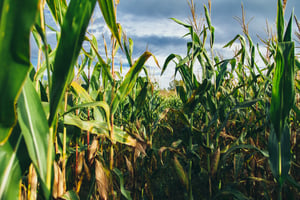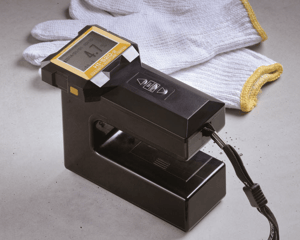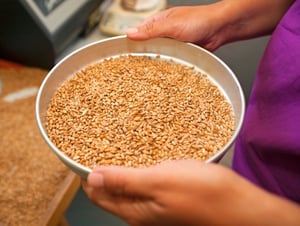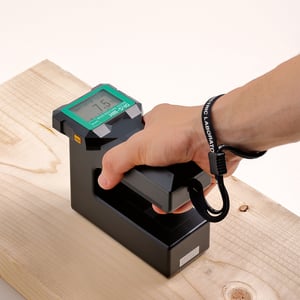 While most growers understand that in an ideal world, corn crops would all be harvested when they reach the standard moisture level of 15.5 percent, these same growers would be quick to tell you that when it comes to farming, there is no “ideal world,” and that each growing season brings it's own unique set of challenges.
While most growers understand that in an ideal world, corn crops would all be harvested when they reach the standard moisture level of 15.5 percent, these same growers would be quick to tell you that when it comes to farming, there is no “ideal world,” and that each growing season brings it's own unique set of challenges.
When looking at corn crop yield, quality, and profitability, growers have to account for things like drying costs for grain that’s harvested and delivered at moisture levels above the 15.5 percent threshold. If they wait too long for their corn crops to dry, growers may have to deal with severe, wet weather that can damage crops. If they harvest their corn crops too soon, growers have to pay high fees per bushel to dry their crops, cutting into their profits.
What do we know about corn crops and their harvest times?
- 38 percent of corn crop acres harvested are between 15.5-18.5 percent moisture
- The wetter the corn, the slower the harvest speed
- Farmers in the northern and eastern Corn Belt states are likely to harvest corn at 18 to 20 percent moisture
- Farmers in western and southern Plains states are likely to harvest corn at 15 to 18 percent moisture
But what is the right time for your corn crop? What moisture levels are optimal?
What Moisture Level is Best for Harvest?
At what moisture level should you begin the harvest of your corn crop? There’s no one right answer. The solution rests heavily on factors that are unique to your crop, region, weather patterns, and even the equipment at your disposal.
There are all kinds of factors that growers must consider when deciding the right time to harvest corn crops. Perhaps the largest fact is field loss, which refers to losses that make it challenging to estimate the true harvest yield thanks to challenges like:
- Ear losses from lodging or ear drop
- Combined losses as the result of difficulty when threshing the grain
- Losses from ear rot
- Kernel respiration that leads to loss of kernel weight
Without having to plan for these factors, the best moisture level for harvesting corn would always be 15.5 percent. However, since harvest occurs at a time of year when many kinds of active weather situations like tropical storms and hurricanes are at their peak, farmers have to consider these issues when they are deciding when to harvest.
Severe storms and periods of wet weather can have a huge impact on the total corn crop yield. For this reason, growers in high-risk areas should begin their harvest when the moisture level reaches the maximum dollar amount for the drying cost per bushel they can afford.
Think of it this way: If a bushel of corn is worth $4.00 per bushel, an approximate drying cost of $0.50 per bushel equates to a harvest loss of 12.5 percent. Growers should review records from years past to see how severe weather or prolonged periods of rain correlated to field loss, and use this information in conjunction with drying costs to determine when to begin harvesting.
Another major factor in selecting the optimum harvest time is the price of corn. As the price of corn increases, the moisture level at which it becomes profitable to harvest also increases. Growers who can receive $6.00 per bushel only need to have an 8 percent harvest loss to afford a drying cost of $0.50 per bushel.
Additionally, growers need to account for the total time it will take to complete their harvest. Growers who have high-capacity equipment and can finish their harvest fairly quickly have more wiggle room, and can start their harvest closer to their target moisture level. Those who have less harvest, hauling, storage, or drying capacity may need to start their harvest at a higher target moisture level to limit field losses as the weather changes.
Know Your Moisture Levels
In the past, growers have used benchmark kernel maturity stages to estimate the right time to harvest corn, but there are a lot of variables that can still impact overall harvest quality even when accounting for these kernel stages. Because of these variables, farmers are also encouraged to periodically check the whole-plant moisture levels of their plants from various fields on their farm, from several locations in each field. This gives the grower a better idea of the actual moisture content of their crops as a whole.
The success of this kind of strategy is dependent on getting accurate moisture readings of these samples—even in the field. Testing instruments like the PM450 Advanced Grain and Seed Moisture Meter come with 26 calibrations for grains including corn, wheat, barley, soybeans, and beans that can be adjusted for local conditions. The PM450 can provide growers with accurate, instant, non-destructive measurements without the pre-processing of samples like some other competitor devices require, making it faster and easier than ever to collect accurate moisture data.
Additionally, the OT300 Harvest Determiner can measure daily temperature readings in the field once the corn grains are formed to pinpoint when the crop’s ripeness reaches its peak in a specific area, to help optimize crop yields and improve grain quality.
Kett has been in the business of providing growers the quality test instrumentation they need to optimize their crops for decades. To learn more about what we can do for you, contact us today!



